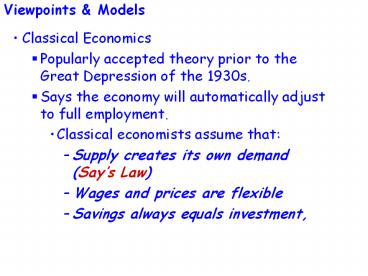Classical Economics PowerPoint PPT Presentation
1 / 23
Title: Classical Economics
1
Viewpoints Models
- Classical Economics
- Popularly accepted theory prior to the Great
Depression of the 1930s. - Says the economy will automatically adjust to
full employment. - Classical economists assume that
- Supply creates its own demand (Says Law)
- Wages and prices are flexible
- Savings always equals investment,
2
Viewpoints Models
- Classical Economics (cont.)
3
Viewpoints Models
- Keynesian Economics
- Based on the work of John Maynard Keynes, who
focused on the role of aggregate spending in
determining the level of macroeconomic activity. - Introduced the idea that a macroeconomy seeks an
equilibrium output level. - Macroeconomic Equilibrium
- Occurs when the amount of total planned spending
on new goods and services equals total output in
the economy. - If aggregate spending is greater than current
production, then output, employment, and income
will all increase, assuming that full employment
has not been reached, and vice versa. - Inventories
- Stocks of goods on hand.
- Allows for spending to exceed current production.
4
Viewpoints Models
- Keynesian Economics (cont.)
5
(No Transcript)
6
(No Transcript)
7
3.00 2.50 2.00 1.50 1.00 0.50 0
1.00 2.00 3.00
8
The Consumption Function
Planned consumption(trillions of )
45º line
12
9
6
3
45º
Real disposable income(trillions of dollars)
3
6
9
12
9
Savings
Consumption
10
Viewpoints Models
- Keynesian Economics (cont.)
11
Viewpoints Models
- Keynesian Economics (cont.)
- Use government expenditures and taxes to control
the level of economic activity. - A recession could be counteracted by increasing
aggregate spending through - Increasing government expenditures on goods and
services - Increasing transfer payments
- Lowering taxes
12
Viewpoints Models
- Keynesian Economics (cont.)
13
Viewpoints Models
- New Classical Economics
- Return to the basic classical premise that free
markets automatically stabilize themselves and
that government intervention in the macroeconomy
is not advisable. - Brought about by what some argued to be holes in
Keynesian economics principles, which could not
explain or remedy some problems of the 1970s. - Stagflation
- Occurs when an economy experiences high rates of
both inflation and unemployment. - More sophisticated explanations of aggregate
demand and aggregate supply.
14
Viewpoints Models
- New Classical Economics (cont.)
- Downward-sloping aggregate demand curve was
explained through - Interest Rate Effect
- Interest rate moves with changes in overall
prices. - An inverse relationship exists between the
interest rate and the amount people borrow and
spend. - Wealth Effect
- In order to maintain the same amount of
accumulated wealth, people spend less when prices
rise and more when prices fall. - Foreign Trade Effect
- A direct relationship exists between changes in
overall prices in an economy and spending on
imports that diverts spending from domestically
produced output.
15
Viewpoints Models
- New Classical Economics (cont.)
16
Viewpoints Models
- New Classical Economics (cont.)
- Aggregate supply curve could be viewed in two
ways - Short-run supply with three phases
- At low levels of output, the aggregate supply
curve is perfectly horizontal. - As output increases beyond a certain point, a
direct relationship between prices and output is
established. - At high levels of output, the aggregate supply
curve becomes perfectly vertical. - Long-run supply
- Perfectly vertical at the natural rate of
unemployment, the point to which the economy will
move.
17
Viewpoints Models
- New Classical Economics (cont.)
18
Viewpoints Models
- New Classical Economics (cont.)
- Long Run Policy Implications
- Natural Rate Hypothesis
- Over the long run, unemployment will tend toward
its natural rate, and policies to reduce
unemployment below that level will be
ineffective. - Adaptive Expectations
- Households and businesses base their expectations
of the future on past and current experiences. - Rational Expectations
- Households and businesses base their expectations
of future policies on how they think they will be
affected by these policies.
19
Viewpoints Models
- New Keynesian Economics
- Builds on the Keynesian view that the economy
does not automatically return to full employment. - Regards prices and wages as inflexible (or
sticky) downward rather than flexible as other
schools believe. - Monetarism
- School of thought that favors stabilizing the
economy through controlling the money supply. - Supply-Side Economics
- Policies to achieve macroeconomic goals by
stimulating the supply side of the market. - Became popular in the 1980s.
20
Inflation Unemployment
- Phillips Curve
- Curve showing the relationship between an
economys unemployment and inflation rates.
21
Inflation Unemployment
- Phillips Curve (cont.)
22
Inflation Unemployment
- Phillips Curve (cont.)
- Three factors may help to explain shifts in the
Phillips curve - Structural changes in the labor force
- 1970s Increase in the labor force participation
rates of women and teenagers who, at the time,
had higher unemployment rates than men. - 1980s 1990s Rate of unemployment for women
fell, the movement of teenagers into the market
reversed itself, and an increase in the rate of
involuntary part-time employment. - Cost-push inflation
- 1970s 1980s Brought about by energy price
increases. - Eligibility for government transfer payments
- Availability of transfer payments increases
unemployment, and vice versa.
23
Macroeconomic Viewpoints Summary
- Viewpoints Summary
- No theory is designed to explain all the complex
relationships among the players and institutions
of a macroeconomy. - The economy is not composed of a set of simple
relationships that can be easily manipulated to
neatly solve various problems as they arise. - Assessing economic theories would be easier if we
lived in closed economies. - Closed Economies
- Economy where foreign influences have no effect
on output, employment, and prices. - Open Economies
- Economy where foreign influences have an effect
on output, employment, and prices.

